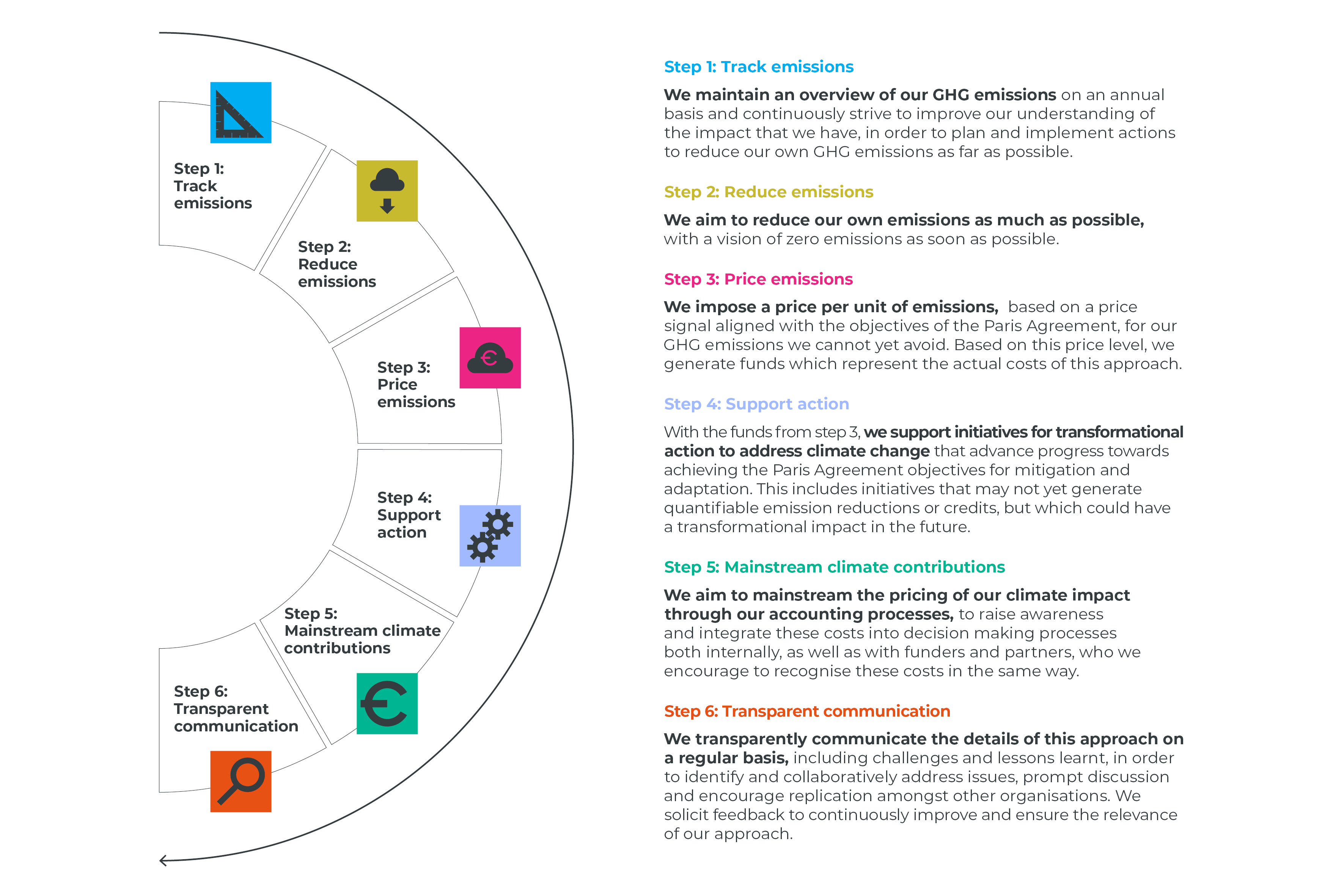Our Climate Responsibility Approach
A new approach for organisations to take responsibility for their climate impact

To address the climate crisis, rapid decarbonisation is urgently needed across all sectors. Existing climate pledges and policies fall far short of what is needed to transition to sustainable, low-carbon economies (Climate Action Tracker, 2020). Organisations increasingly recognise that their activities are drivers of this problem and feel compelled to step up and take responsibility for their impact on the climate. Common approaches to address this responsibility – such as shadow carbon pricing or the concept of offsetting – are challenging to implement in a way that ensures transparency and effective climate impact in line with the Paris Agreement objectives.
Our climate responsibility approach addresses our own climate footprint in a transparent and constructive way. We set out to do the following:
We do not intend to offset our emissions and do not strive for carbon neutrality, based on offsets. We aim to create a transparent mechanism that reduces our direct climate impact and channels resources to initiatives that currently deliver real impact in addressing climate change or have great potential to do so in the future. In this document we hope to outline a transparent mechanism that can be followed by others.
To address the climate crisis, rapid decarbonisation is urgently needed across all sectors. Existing climate pledges and policies fall far short of what is needed to transition to sustainable, low-carbon economies (Climate Action Tracker, 2020). Organisations increasingly recognise that their activities are drivers of this problem and feel compelled to step up and take responsibility for their impact on the climate. Common approaches to address this responsibility – such as shadow carbon pricing or the concept of offsetting – are challenging to implement in a way that ensures transparency and effective climate impact in-line with the Paris Agreement objectives.
Our “Climate responsibility” approach addresses our own climate footprint in a transparent and constructive way.
Together with clients and project partners, NewClimate works towards a sustainable zero-GHG emission future. Through our work we help governments, the international community and other stakeholders to identify opportunities and appropriate policies to transition towards zero-GHG emission strategies. We advocate for a rapid and deep decarbonisation of societies, in a manner that allows for sustainable development. We are convinced that our work contributes to mitigating climate change. However, in conducting some of our project activities and through our procurement we recognise that we are also, in part, causing GHG emissions. Some of our activities do not come with a feasible zero-emission solution at the moment. This includes, most importantly, air travel, but also some of our office operations and related services.
The following steps outline our approach to address our Climate Responsibility. We recognise challenges in the approach and the solutions that we identify, and seek to transparently document the full details of our approach on an annual basis, including these uncertainties. We aim to establish a transparent approach that can be adopted by others.
We maintain an overview of our GHG emissions on an annual basis and continuously strive to improve our understanding of the impact that we have.
NewClimate Institute performs a transparent ongoing analysis of the organisation’s GHG emissions, reporting on an annual basis.
The scope of the company’s own emissions accounting is reviewed and publicly communicated on an annual basis, with the intention to continuously improve our understanding of our climate impact and measures available to mitigate this.
The estimation of GHG emissions includes the estimated equivalent climate impact of non-carbon climate forcers from aviation, such as condensation trails, ice clouds and ozone generated by nitrogen oxides.
Details on the scope of our emissions accounting are included in Chapter 1 of our annual implementation report found here.
We aim to reduce our own emissions as much as possible, with a vision of zero emissions as soon as possible.
NewClimate Institute has a vision to operate with zero GHG emissions as soon as possible.
We regularly assess the options for reducing our own emissions from each emission source, based on the results from step 1 and taking account of the best available knowledge on emission reduction opportunities.
We derive an action plan for reducing emissions each year. The internal price for carbon applied in Step 3 of this approach also supports driving decision making towards low-carbon solutions.
For important sources of emissions where we cannot make significant emission reductions in the near future, we transparently communicate the challenges we face in tackling those emission sources, to encourage a dialogue on finding solutions for the future.
Details on the current action plan for reducing emissions are included in our annual implementation report found here.
We impose a price per unit of emissions, based on a price signal aligned with the objectives of the Paris Agreement, for our GHG emissions we cannot yet avoid. Based on this price level, we generate funds which represent the actual costs of this approach.
Although our vision is to operate at zero emissions as soon as possible, there are technical and economic reasons why it is not yet feasible for NewClimate Institute to reduce all of our emissions to zero. In particular, alternative technologies do not yet exist commercially to significantly reduce emissions from necessary flight activity.
Although a useful concept in the era of the Kyoto Protocol, we consider the approach of “offsetting” emissions to have limitations against the objectives of the Paris Agreement, and not ambitious enough for an organisation that understands the need to move towards full decarbonisation in the first half of the century. As such, we do not seek to offset our emissions or to claim “carbon neutrality”.
Rather, we apply a price per unit of GHG emissions estimated in Step 1. We determine the price level based on the best available scientific evidence on the carbon price signal required for alignment with the Paris Agreement objectives. We review this price level each year in the light of new evidence. We communicate our determined price level and rationale in our annual implementation report found here.
Based on this price level and the emissions from step 1, we annually generate funds which represent the actual costs of this approach.
With the funds from step 3, we support initiatives for transformational action to address climate change that advance progress towards the achievement of the Paris Agreement objectives for mitigation and adaptation.
The funds from our internal pricing of unavoided emissions are used to support high impact projects for action to address climate change, with a particular focus on mitigation and adaptation, through grant donations.
Since we do not intend to claim carbon neutrality, we do not actively seek to buy certified credits for emission reductions, although we do not rule out providing support to project types that could also potentially be financed in-part or fully through carbon credits. We recognise that some of the activities with the highest transformation potential – and therefore with high suitability for supporting the objectives of the Paris Agreement – may be at early stages of development and/or may carry a risk of not delivering attributable emission reductions.
We engage in dialogue with other stakeholders, including existing platforms within the voluntary carbon markets, to identify and continuously improve the available options to channel our resources in line with our objectives. We believe there is a significant role for existing voluntary carbon market actors, including those that have previously administered crediting programmes, to consider new approaches that can address this current gap in the market.
We transparently communicate details on the approach pursued for the use of these funds in our annual implementation report found here.
We aim to mainstream the pricing of our climate impact through our accounting processes, to raise awareness and integrate these costs into decision making processes both internally, as well as with funders and partners.
NewClimate pursues the following measures to mainstream the pricing of our GHG emissions and wider climate impacts throughout our accounting and decision-making processes, internally and with our funders and partners:
- Emissions from project-specific activities, such as project-related travel, are attributed as cost items to their respective project cost lines.
- Staff travel expense reports include the costs of the emissions associated with the travel, alongside the quantification of the climate impact from that travel. This serves to raise awareness and also provide evidence of our costs that can be made available to clients.
- We aim to communicate GHG emissions that can be attributed to specific projects, and their associated costs, to clients. We also aim to explore options to include these in the costs that we report to the client for the payment of our services or reimbursement of our expenses. We anticipate that some of our clients may not initially agree to cover these costs, but through our communication we attempt to raise awareness and convince them to adopt climate responsible procurement practices.
- We attempt to foresee costs associated with our climate impact and aim to include them in our proposals for new projects. We aim to raise awareness with our funders of the need to recognise and seek to address climate impacts associated with their service procurement to minimise the risk of eroding our cost competitiveness. Likewise, we will attempt to have the recognition of these costs included in all new contracts with clients and partners.
We transparently communicate the details of this approach and its implementation on a regular basis.
Transparent communication is a key foundation of this approach. Constructive, collaborative dialogue is required to overcome challenges and share lessons learnt in order to identify and address issues that can support enhanced action and accelerated decarbonisation.
Through our communication, we aim to prompt discussion and encourage replication amongst other organisations. We solicit feedback to continuously improve and ensure the relevance of our approach.
NewClimate documents and publishes the full details of the approach including the following aspects:
- Introductory explanation of the Climate Responsibility approach.
- Annual implementation reports including 6 chapters to communicate progress on the 6 steps:
- Overview of the organisation’s own emissions, as per Step 1.
- Details of actions identified for reducing own emissions in the following year, and key challenges faced, as per Step 2.
- The price level determined per unit of emissions, including explanation for this choice, as per Step 3.
- Details on how the funds have been used to support climate change action, and the expected impacts, as per Step 4.
- An update on the extent to which mainstreaming of our emissions’ pricing in our own accounting process has been successful, including information on whether clients have accepted the costs, as per Step 5.
- A checklist summary of what has been communicated and published to report on implementation of the approach during the past year.
Limitations of claiming carbon neutrality through offsetting in the context of the Paris Agreement
NewClimate Institute’s Climate Responsibility approach provides an alternative approach to claiming carbon neutrality through offsetting which, although a useful concept historically, has a number of limitations and risks under the global governance framework of the Paris Agreement.
Claiming carbon neutrality through offsetting may divert attention from the fact that, to meet the objectives of the Paris Agreement, we need to reach zero GHG emissions worldwide. A climate responsibility approach needs to first and foremost incentivise and facilitate the reduction of one’s own emissions.
Carbon neutrality claims that significantly depend on use of offsets are not conducive to the achievement of the Paris Agreement objectives, which require the full decarbonisation of all economies, and transparent dialogue to support that achievement.
The Paris Agreement highlights the importance of transparency and facilitative dialogue for ambition raising. In this regard, we consider that a transparent communication of an organisation’s own emissions and the plans and challenges faced in reducing emissions further, is more constructive than a subjective claim to carbon neutrality delivered through offsets.
Industries, organisations and individuals who have built brand recognition on the claim of carbon neutrality may find it an unattractive prospect to divert from this approach. However, consumer awareness on responsible climate action is increasing. Over time, consumers may recognise that carbon neutrality claims do not necessarily represent high ambition for decarbonisation and do not always advance the objectives of the Paris Agreement through transparency and facilitative dialogue.
The prospect of generating investment through offset credits could present countries with a perverse incentive to limit the extent to which they ratchet-up their own ambition in reducing emissions. The integrity of credited emission reductions for their buyers is now far more uncertain in the context of the Paris Agreement.
The Paris Agreement requires all countries to set self-determined emission reduction targets (Nationally Determined Contributions – NDCs), which are to be revised at least every five years to reflect each country’s highest possible ambition level.
Emission reduction credits that are sold for offsetting purposes should not be counted towards the achievement of a host country’s GHG emission reduction target, to avoid that those emission reductions are double counted. As such, the prospect of potential revenues from emission reduction credits associated with offsetting programmes may present countries with a perverse incentive to restrict the extent to which they ratchet-up the ambition of their unilateral action during NDC revision cycles. In order to maximise the amount of foreign investment, countries may limit their own national GHG emission reduction targets so that more of their mitigation potential can be tapped by international offsetting mechanisms.
This situation also entails a risk for buyers of offset credits related to the integrity of those credits. A key condition for determining the integrity of offset credits is the additionality of the emissions reduction project; that is, the guarantee that credited emission reductions are additional to what could be achieved without the offsetting programme. In historical mechanisms, additionality could be proven by showing that the activity was not required by local legislation and that offsetting revenues could help overcome barriers that would otherwise prevent implementation. Since, under the Paris Agreement, all countries now have their own emission reduction targets and the requirement to regularly ratchet-up their ambition levels, this situation calls for the re-definition of the concept of additionality: additionality should imply complete certainty that the project supported could not realistically have been implemented otherwise, through unilateral ambition enhancements on the part of the host country.
Stringent safeguards would be needed to avoid or reduce the effects of such perverse incentives and to ensure additionality. Offsetting programmes would need to ensure that they only tap highly ambitious mitigation options, which are beyond the reasonable reach of the host country’s unilateral action and which do not represent a conflict with the country’s own mitigation targets. Such stringent safeguards would be technically and politically difficult to establish. Even then, perverse incentives would remain to push the boundaries of those safeguards and seek loopholes.
Since emission reduction projects registered under crediting programmes to date have been mostly developed in the context of cost-saving, rather than ambition-raising mechanisms, we understand that there are very few, if any, examples of existing credited projects that represent those high-hanging fruits, and which could be considered truly additional in the context of the Paris Agreement. Given the difficulty in objectively determining additionality in line with this definition, we consider that only a niche and ever reducing number of activities could count for this, and that this does therefore not represent a viable option for rapidly increasing demand volume of the market.
Financial support can have a greater impact for ambition raising in developing countries, if ownership of the emission reduction outcomes remains with the host country.
Developing countries need more financial support to ramp up their mitigation action, and voluntary action is a vital channel of such support. However, a more constructive environment is required in which this finance positively reinforces ambition raising efforts, rather than providing perverse incentives. In contrast to offsetting approaches, if the financial support from voluntary action results in emission reductions that are owned by the host country, this represents no conflict with the host country’s GHG emission reduction target, but rather can provide support for reaching and ratcheting up those targets.
Offset credits are not necessary for the achievement of the Paris Agreement, but climate finance to support climate change mitigation in developing countries – also from voluntary sources – is critical and must be significantly ramped up.
Whilst we do not recognise a need for credited projects or carbon neutrality claims to advance the objectives of the Paris Agreement, we do recognise the importance of continued and rapidly increasing volumes of climate finance for many potential emission reduction initiatives in developing countries. Through the Climate Responsibility approach in which the determined price per tonne is based on a price signal aligned with the objectives of the Paris Agreement, the volume of climate finance flows from voluntary action could vastly exceed that which would flow under the continuation of credited market approaches.
We publish our organisation's implementation report once a year.
If you would like to find out more about our climate responsibility approach, you can contact us directly with any questions or feedback, or to discuss interest in potential collaboration: @email.
You can find our annual implementation reports here:
- Implementation report 2025
- Implementation report 2024
- Implementation report 2023
- Implementation report 2022
- Implementation report 2021
- Implementation report 2020
More information on the overall concept and projects we support are here:





